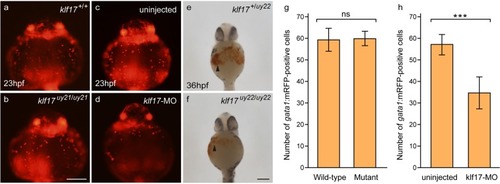
Primitive erythrocytes were observed in the klf17-deficient embryos. (a–d) Production of primitive erythrocytes in the klf17-deficient embryo and in the klf17-morphant embryo at 23 hpf. The number of erythrocytes visualized by the gata1:mRFP transgene was comparable in wild-type embryo (klf17+/+) (a) and the klf17-deficient embryo (klf17uy21/uy21) (b) (ventral view, anterior up), whereas the number of erythrocytes was less in the klf17-morphant embryo (d). Scale bar, 200 μm. (e,f) Haemoglobin production in the klf17-deficient embryos at 36 hpf. Haemoglobin production visualized by o-dianisidine staining (arrowheads) was detected in the wild-type embryo containing an intact allele (klf17+/uy22) embryo and in the klf17-deficient embryo (klf17uy22/uy22) (ventral view, anterior up). After taking pictures, genotyping of individual embryos was performed by genomic PCR. Scale bar, 200 μm. (g) The number of gata1:mRFP-positive cells on the yolk in wild-type (n = 19) and in the klf17-deficient embryos (mutant) (n = 8) were counted. Error bars indicate standard deviation. ns, not significant. (h) The number of gata1:mRFP-positive cells on the yolk in uninjected (n = 14) and in the klf17-molpholino (10 ng)-injected embryos (n = 19) were counted. Asterisk indicates statistical significance. ***P < 0.001. Error bars indicate standard deviation.
|

